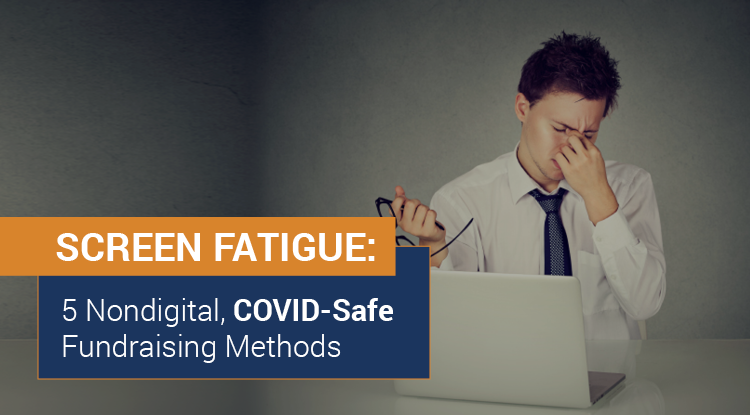Screen Fatigue: 5 Non-Digital, COVID-Safe Fundraising Methods

As a nonprofit professional, you surely know that fundraising efforts have drastically shifted across the board as a result of COVID-19—and you’ve likely even seen these changes firsthand. For one thing, the majority of in-person fundraising efforts have transitioned to the virtual realm.
Yet as we continue to seek new and successful ways to fundraise in the months and years to come, it’s important to recognize that entirely digital campaigns can get tiresome as well, both for the fundraisers and the donors.
At GivingMail, we know that strategic nonprofit fundraising practices are critical for maintaining a fully-funded organization that can drive its mission forward in the most effective ways possible. In this case, that means looking to out-of-the-box solutions for combatting screen fatigue and fundraising issues simultaneously.
When it comes to screen fatigue and nonprofit fundraising, here are a few powerful campaign ideas that can set you up for success without asking your donors to spend more time on a computer or smartphone:
1. Send direct mail appeals
2. Organize a shoe drive
3. Plan a distanced walk-a-thon
4. Create fundraising postcards
5. Host a give-it-up challenge
Before we dive into our favorite fundraising ideas, let’s address some questions you might have on the topic of screen fatigue and fundraising.
What is screen fatigue?
Screen fatigue, also known as eyestrain or computer/digital fatigue, is a concept that most people have become familiar with in recent months—whether they know the term for it or not. Symptoms can include sore or irritated eyes, difficulty focusing, and blurred or double vision. Although these effects are rarely serious, it can be uncomfortable to deal with when so much of our daily lives are reliant on technology. The solution? Stepping away from the screens.
What does screen fatigue have to do with fundraising?
In a world where much of school, work, entertainment, and even socialization take place on the internet, your donors might not be thrilled by the idea of hopping online to support your cause as well. When it comes to planning fundraisers in 2021, it’s a good idea to throw a couple of non-digital campaign ideas into the mix—while still adhering to social distancing guidelines, of course.
And what kind of fundraising ideas meet both those criteria? Let’s jump into a few of our favorite suggestions.
1. Direct Mail Appeals
According to the GivingMail guide to direct mail for nonprofits, individual donations account for roughly 70% of all charitable giving—with direct mail appeals continuing to lead the charge. And while so many businesses and organizations are vying for your audiences’ attention, a direct mail appeal might be exactly what you need to break through the digital clutter and ensure your own cause stands out among the crowd.
To make the most out of your appeals and encourage supporters to give, you should consider these best practices:
- Personalize your appeals to address the recipient by name and incorporate other relevant information.
- Segment your audience by shared characteristics such as demographics, geographic location, history of support, giving preference, and more.
- Make giving as easy as possible by including a pre-paid, pre-addressed reply envelope within your appeal.
Sending direct mail appeals also offers a unique and personal touchpoint that works to deepen your relationship with donors—which is something that all too often is lacking in digital communications.

2. Shoe Drive
Another great way to raise money while remaining safe and healthy during COVID is by hosting a shoe drive. By calling on supporters to donate running shoes—including gently worn, used, and new shoes—you can collect a ton of shoes that can be traded to a fundraising company in exchange for a check to your organization.
Here’s how this fundraising idea works:
- Partner with a shoe drive fundraising company that will provide you with collection materials.
- Set up collection boxes at well-trafficked areas around your community such as your office or local stores or restaurants.
- Spread the word about your shoe drive fundraiser and encourage supporters to clean out their closets or purchase shoes to donate.
- End your shoe drive after a week or so, contact your fundraising company to collect the shoes, and wait for your check!
This is an excellent fundraiser to hold in the COVID season especially because you never have to ask donors for a monetary contribution. Since many of your supporters have likely been negatively impacted by the pandemic and its economic effects, this is a great opportunity for donors to get involved without having to reach into their wallets.
Plus, it’s a fantastic way to get a head start on spring cleaning by going through old shoes and donating ones that no longer fit or are otherwise not needed.
3. Distanced Walk-a-Thon
Walking outdoors is another healthy habit that many have picked up during the pandemic, and this fundraising idea encourages that behavior while also raising much-needed funding for your cause. It’s a win-win!
According to 99Pledges’ walk-a-thon fundraiser guide, the general process looks like this:
- You’ll recruit dedicated supporters who are willing to take on the role of a fundraiser for your organization.
- You’ll provide each participant with a customizable donation page and encourage them to share why they’re raising money for your mission.
- Participants share their donation page with their networks of family, friends, colleagues, and other community members and ask for their support.
- Sponsors pledge a certain dollar amount per distance walked/run (i.e. $5 for every mile completed by the participant).
- Participants complete their walk-a-thon and track their time/distance to calculate donations.
- Sponsors follow up and donate the agreed-upon amount depending on their sponsee’s walk-a-thon results.
While a traditional fundraising walk typically involves a number of participants walking a predetermined event path, a socially distanced walk-a-thon will have a key difference: each participant walks a path of their choosing on their own. They’ll track their progress with a smartphone app or fitness watch and report back to your organization. This way, participating fundraisers can stay safe and healthy on their isolated path, while still experiencing the excitement that is a charity walk-a-thon.
4. Fundraising Postcards
If you’re looking for a quick and easy way to get your name out to supporters and raise funds and awareness for your cause, fundraising postcards are the perfect tool.
This guide positions fundraising postcards as “a unique alternative to traditional fundraising letters,” explaining that while postcards can’t carry as much information as a typical direct mail appeal, it can be a great way to get the most important details in front of the recipient.
Another huge advantage of fundraising postcards, as opposed to more traditional direct mail appeals, is that you forego the roadblock of getting the recipient to open your envelope in the first place. By including everything the reader needs to know directly on the mailing, odds are good that they’ll at least skim your appeal before deciding whether or not to engage.
The only drawback with sending postcards is that it’s harder to create a high-quality appeal on your own. But by working with a direct mail fundraising company, they can help you create and send well-designed and skillfully executed postcard campaigns. Then, you can save your team’s time, money, and effort that can be reinvested in what really matters—your mission.
5. Give-it-Up Challenge
In a give-it-up challenge, your organization will recruit individuals who are willing to forego their favorite drinks, snacks, or meals for a period of time while donating the money they would have spent on those luxuries to your mission. In a time when people are staying in more and eating out less anyway, this can be an excellent fundraising opportunity to leverage for your cause.
For example, imagine your supporter Bobby typically buys a $5 latte on his way to work every morning. He hears about your give-it-up challenge and would like to take part in the fundraiser. He agrees to give up his favorite coffees for one month and give that chunk of money to his favorite charity (yours) instead. At five lattes a week for four weeks, that’s $100 right there!
When you get others on board along with Bobby, that money can add up for your cause very quickly.
Despite the economic challenges brought on by COVID-19, many organizations are continuing to see generous financial support from their donors. Yet in order to maximize revenue, it’s important to take donor wants and needs into account as well—meaning giving the screens a rest. By planning and hosting nondigital yet COVID-safe fundraising ideas, you can set your team and its mission up for continued success. Best of luck!
Grant Cobb is a fundraising specialist with over 6 years of experience in the nonprofit space. Currently the head of marketing and analytics at GivingMail, he is a huge proponent of data-driven decision-making and the push to bring high-level analytics and fundraising to all.